Novel Linear Trinuclear CuII Compound with Trapped Chiral Hemiaminal Ligand: Magnetostructural Study
Abstract
1. Introduction
2. Experimental
2.1. Synthesis of Compound H2L
2.2. Synthesis of Compound {[Cu3(HL′)2(H2O)2](ClO4)4}·(H2O)4 (1)
2.3. X-ray Crystal Structure Analysis
2.4. Magnetic Measurement
2.5. Theoretical Calculations
3. Results and Discussion
3.1. Synthetical Approach
3.2. Description of the Crystal Structure
3.3. Magnetic Properties
3.4. Theoretical Calculations
4. Conclusions
Supplementary Materials
Author Contributions
Funding
Institutional Review Board Statement
Informed Consent Statement
Data Availability Statement
Acknowledgments
Conflicts of Interest
References
- De Han, S.; Zhao, J.P.; Liu, S.J.; Bu, X.H. Hydro(Solvo)Thermal Synthetic Strategy towards Azido/Formato-Mediated Molecular Magnetic Materials. Coord. Chem. Rev. 2015, 289–290, 32–48. [Google Scholar] [CrossRef]
- Salvadeo, E.; Dubois, L.; Latour, J.M. Trinuclear Copper Complexes as Biological Mimics: Ligand Designs and Reactivities. Coord. Chem. Rev. 2018, 374, 345–375. [Google Scholar] [CrossRef]
- Chen, Q.F.; Cheng, Z.Y.; Liao, R.Z.; Zhang, M.T. Bioinspired Trinuclear Copper Catalyst for Water Oxidation with a Turnover Frequency up to 20000 S-1. J. Am. Chem. Soc. 2021, 143, 19761–19768. [Google Scholar] [CrossRef] [PubMed]
- Smits, N.W.G.; Rademaker, D.; Konovalov, A.I.; Siegler, M.A.; Hetterscheid, D.G.H. Influence of the Spatial Distribution of Copper Sites on the Selectivity of the Oxygen Reduction Reaction. Dalt. Trans. 2022, 51, 1206–1215. [Google Scholar] [CrossRef] [PubMed]
- Muñoz-Becerra, K.; Zagal, J.H.; Venegas, R.; Recio, F.J. Strategies to Improve the Catalytic Activity and Stability of Bioinspired Cu Molecular Catalysts for the ORR. Curr. Opin. Electrochem. 2022, 35, 101035. [Google Scholar] [CrossRef]
- Altowyan, M.S.; Khalil, S.M.S.M.; Al-Wahaib, D.; Barakat, A.; Soliman, S.M.; Ali, A.E.; Elbadawy, H.A. Synthesis of a Novel Unexpected Cu(II)–Thiazolidine Complex—X-Ray Structure, Hirshfeld Surface Analysis, and Biological Studies. Molecules 2022, 27, 4583. [Google Scholar] [CrossRef]
- Pandolfo, L.; Pettinari, C. Trinuclear Copper(Ii) Pyrazolate Compounds: A Long Story of Serendipitous Discoveries and Rational Design. CrystEngComm 2017, 19, 1701–1720. [Google Scholar] [CrossRef]
- Geer, A.M.; Musgrave, C.; Webber, C.; Nielsen, R.J.; McKeown, B.A.; Liu, C.; Schleker, P.P.M.; Jakes, P.; Jia, X.; Dickie, D.A.; et al. Electrocatalytic Water Oxidation by a Trinuclear Copper(II) Complex. ACS Catal. 2021, 11, 7223–7240. [Google Scholar] [CrossRef]
- Kintzel, B.; Böhme, M.; Liu, J.; Burkhardt, A.; Mrozek, J.; Buchholz, A.; Ardavan, A.; Plass, W. Molecular Electronic Spin Qubits from a Spin-Frustrated Trinuclear Copper Complex. Chem. Commun. 2018, 54, 12934–12937. [Google Scholar] [CrossRef]
- Rabelo, R.; Stiriba, S.E.; Cangussu, D.; Pereira, C.L.M.; Moliner, N.; Ruiz-García, R.; Cano, J.; Faus, J.; Journaux, Y.; Julve, M. When Molecular Magnetism Meets Supramolecular Chemistry: Multifunctional and Multiresponsive Dicopper(Ii) Metallacyclophanes as Proof-of-Concept for Single-Molecule Spintronics and Quantum Computing Technologies? Magnetochemistry 2020, 6, 69. [Google Scholar] [CrossRef]
- Manzur, J.; Mora, H.; Vega, A.; Venegas-Yazigi, D.; Novak, M.A.; Sabino, J.R.; Paredes-García, V.; Spodine, E. Mononuclear and Polynuclear Copper(II) Complexes Derived from Pyridylalkylaminomethylphenol Polypodal Ligands. Inorg. Chem. 2009, 48, 8845–8855. [Google Scholar] [CrossRef] [PubMed]
- Barros, W.P.; Da Silva, B.C.; Reis, N.V.; Pereira, C.L.M.; Doriguetto, A.C.; Cano, J.; Pirota, K.R.; Pedroso, E.F.; Julve, M.; Stumpf, H.O. Discrete Trinuclear Copper(Ii) Compounds as Building Blocks: The Influence of the Peripheral Substituents on the Magnetic Coupling in Oxamato-Bridged Complexes. Dalt. Trans. 2014, 43, 14586–14595. [Google Scholar] [CrossRef]
- Grenda, S.; Beau, M.; Luneau, D. Synthesis, Crystal Structure and Magnetic Properties of a Trinuclear Copper(II) Complex Based on P-Cresol-Substituted Bis(α-Nitronyl Nitroxide) Biradical. Molecules 2022, 27, 3218. [Google Scholar] [CrossRef] [PubMed]
- Nishida, Y.; Takeuchi, M.; Takahashi, K.; Kida, S. Preparation and Crystal Structure of a Binuclear Copper(II) Complex Bridged by an Alkoxo-Oxygen Atom an Acetate Ion. Chem. Lett. 1983, 12, 1815–1818. [Google Scholar] [CrossRef]
- Nishida, Y.; Takeuchi, M.; Takahashi, K.; Kida, S. Orbital Complementary and Countercomplementary Effects in Superexchange Interaction through Heterobridges in Binuclear Copper(II) Complexes. Chem. Lett. 1985, 14, 631–634. [Google Scholar] [CrossRef]
- McKee, V.; Zvagulis, M.; Dagdigian, J.V.; Patch, M.G.; Reed, C.A. Hemocyanin Models: Synthesis, Structure, and Magnetic Properties of a Binucleating Copper(II) System. J. Am. Chem. Soc. 1984, 106, 4765–4772. [Google Scholar] [CrossRef]
- McKee, V.; Zvagulis, M.; Reed, C.A. Further Insight into Magnetostructural Correlations in Binuclear Copper(II) Species Related to Methemocyanin: X-Ray Crystal Structure of a 1,2-μ-Nitrito Complex. Inorg. Chem. 1985, 24, 2914–2919. [Google Scholar] [CrossRef]
- Herrera, A.M.; Kalayda, G.V.; Disch, J.S.; Wikstrom, J.P.; Korendovych, I.V.; Staples, R.J.; Campana, C.F.; Nazarenko, A.Y.; Haas, T.E.; Rybak-Akimova, E.V. Reactions at the Azomethine C=N Bonds in the Nickel(II) and Copper(II) Complexes of Pyridine-Containing Schiff-Base Macrocyclic Ligands. Dalt. Trans. 2003, 4482–4492. [Google Scholar] [CrossRef]
- Yusuf, T.L.; Oladipo, S.D.; Zamisa, S.; Kumalo, H.M.; Lawal, I.A.; Lawal, M.M.; Mabuba, N. Design of New Schiff-Base Copper(II) Complexes: Synthesis, Crystal Structures, DFT Study, and Binding Potency toward Cytochrome P450 3A4. ACS Omega 2021, 6, 13704–13718. [Google Scholar] [CrossRef]
- Bazhina, E.S.; Bovkunova, A.A.; Medved’ko, A.V.; Efimov, N.N.; Kiskin, M.A.; Eremenko, I.L. Unusual Polynuclear Copper(II) Complexes with a Schiff-Base Ligand Containing Pyridyl and 1,2,4-Triazolyl Rings. J. Clust. Sci. 2019, 30, 1267–1275. [Google Scholar] [CrossRef]
- Biswas, C.; Drew, M.G.B.; Ruiz, E.; Estrader, M.; Diaz, C.; Ghosh, A. Synthesis, Crystal Structure and Magnetic Properties of Three Unprecedented Tri-Nuclear and One Very Rare Tetra-Nuclear Copper(Ii) Schiff-Base Complexes Supported by Mixed Azido/Phenoxo/Nitrato or Acetato Bridges. Dalt. Trans. 2010, 39, 7474–7484. [Google Scholar] [CrossRef]
- Middya, P.; Roy, D.; Chattopadhyay, S. Synthesis, Structures and Magnetic Properties of End-on Pseudo-Halide Bridged Dinuclear Copper(II) Complexes with N,O-Donor Salicylaldimine Schiff Base Blocking Ligands: A Review. Inorganica Chim. Acta 2023, 548, 121377. [Google Scholar] [CrossRef]
- Roubeau, O. Triazole-Based One-Dimensional Spin-Crossover Coordination Polymers. Chem.–A Eur. J. 2012, 18, 15230–15244. [Google Scholar] [CrossRef]
- Klingele, M.H.; Brooker, S. The Coordination Chemistry of 4-Substituted 3,5-Di(2-Pyridyl)-4H-1,2,4-Triazoles and Related Ligands. Coord. Chem. Rev. 2003, 241, 119–132. [Google Scholar] [CrossRef]
- Aromí, G.; Barrios, L.A.; Roubeau, O.; Gamez, P. Triazoles and Tetrazoles: Prime Ligands to Generate Remarkable Coordination Materials. Coord. Chem. Rev. 2011, 255, 485–546. [Google Scholar] [CrossRef]
- Haasnoot, J.G. Mononuclear, Oligonuclear and Polynuclear Metal Coordination Compounds with 1,2,4-Triazole Derivatives as Ligands. Coord. Chem. Rev. 2000, 200–202, 131–185. [Google Scholar] [CrossRef]
- Heras Ojea, M.J.; Hay, M.A.; Cioncoloni, G.; Craig, G.A.; Wilson, C.; Shiga, T.; Oshio, H.; Symes, M.D.; Murrie, M. Ligand-Directed Synthesis of {MnIII5} Twisted Bow-Ties. Dalt. Trans. 2017, 46, 11201–11207. [Google Scholar] [CrossRef] [PubMed]
- Creaven, B.S.; Devereux, M.; Foltyn, A.; McClean, S.; Rosair, G.; Thangella, V.R.; Walsh, M. Quinolin-2(1H)-One-Triazole Derived Schiff Bases and Their Cu(II) and Zn(II) Complexes: Possible New Therapeutic Agents. Polyhedron 2010, 29, 813–822. [Google Scholar] [CrossRef]
- Penkova, L.; Demeshko, S.; Haukka, M.; Pavlenko, V.A.; Meyer, F.; Fritsky, I.O. Bi- and Trinuclear Copper(II) Complexes with a Bridging Pyrazole/Oxime Ligand: Structures and Magnetic Properties. Z. Anorg. Allg. Chem. 2008, 634, 2428–2436. [Google Scholar] [CrossRef]
- Ferrer, S.; Lloret, F.; Pardo, E.; Clemente-Juan, J.M.; Liu-González, M.; García-Granda, S. Antisymmetric Exchange in Triangular Tricopper(II) Complexes: Correlation among Structural, Magnetic, and Electron Paramagnetic Resonance Parameters. Inorg. Chem. 2012, 51, 985–1001. [Google Scholar] [CrossRef] [PubMed]
- Ferrer, S.; Van Koningsbruggen, P.J.; Haasnoot, J.G.; Reedijk, J.; Kooijman, H.; Spek, A.L.; Lezama, L.; Arif, M.; Miller, J.S. Dimetallic Complexes Derived from a Novel Dinucleating Chelating Symmetric Triazole Ligand; Crystal Structure, Magnetic Properties and ESR Study of Bis[m-3,5-Diacetylamino-1,2,4-Triazolato-O’,N1, N2, O’’]Bis[(Nitrato)(Aqua)Copper(II)]. Dalt. Trans. 1999, 23, 4269–4276. [Google Scholar] [CrossRef]
- Li, A.M.; Rentschler, E. 1,2,4-Triazole Schiff Base Directed Synthesis of Polynuclear Iron Complexes: Investigating the Magnetic Properties Going from a Dimer to a 1D Chain to a 3D Framework. Polyhedron 2018, 154, 364–372. [Google Scholar] [CrossRef]
- Liu, Q.; Yao, N.T.; Sun, H.Y.; Hu, J.X.; Meng, Y.S.; Liu, T. Light Actuated Single-Chain Magnet with Magnetic Coercivity. Inorg. Chem. Front. 2022, 9, 5093–5104. [Google Scholar] [CrossRef]
- Sheldrick, G.M. SADABS, 2014/5; Bruker AXS Inc.: Madison, WI, USA, 2014. [Google Scholar]
- Dolomanov, O.V.; Bourhis, L.J.; Gildea, R.J.; Howard, J.A.K.; Puschmann, H. OLEX2: A Complete Structure Solution, Refinement and Analysis Program. J. Appl. Crystallogr. 2009, 42, 339–341. [Google Scholar] [CrossRef]
- Sheldrick, G.M. SHELXT—Integrated Space-Group and Crystal-Structure Determination. Acta Crystallogr. Sect. A Found. Adv. 2015, A71, 3–8. [Google Scholar] [CrossRef] [PubMed]
- Sheldrick, G.M. Crystal Structure Refinement with SHELXL. Acta Crystallogr. Sect. C Struct. Chem. 2015, C71, 3–8. [Google Scholar] [CrossRef] [PubMed]
- Blatov, V.; Shevchenko, A. ToposPro, Program Package for Multipurpose Crystallochemical Analysis, Version 4.0; TOPOS: Singapore, 2014. [Google Scholar]
- Blanton, J.R.; Papoular, R.J.; Louër, D. PreDICT: A Graphical User Interface to the DICVOL14 Indexing Software Program for Powder Diffraction Data. Powder Diffr. 2019, 34, 233–241. [Google Scholar] [CrossRef]
- Rodríguez-Carvajal, J.; Roisnel, T. Line Broadening Analysis Using Fullprof: Determination of Microestructural Properties. Mater. Sci. Forum 2004, 443–444, 123–126. [Google Scholar] [CrossRef]
- Roisnel, T.; Rodríguez-Carvajal, J. WinPLOT: A Windows Tool for Powder Diffraction Pattern Analysis. Mater. Sci. Forum 2001, 378–381, 118–123. [Google Scholar] [CrossRef]
- Bain, G.A.; Berry, J.F. Diamagnetic Corrections and Pascal’s Constants. J. Chem. Educ. 2008, 85, 532–536. [Google Scholar] [CrossRef]
- Neese, F. The ORCA Program System. Wiley Interdiscip. Rev. Comput. Mol. Sci. 2012, 2, 73–78. [Google Scholar] [CrossRef]
- Noodleman, L.; Norman, J.G. The Xα Valence Bond Theory of Weak Electronic Coupling. Application to the Low-Lying States of Mo2Cl84−. J. Chem. Phys. 1979, 70, 4903–4906. [Google Scholar] [CrossRef]
- Noodleman, L. Valence Bond Description of Antiferromagnetic Coupling in Transition Metal Dimers. J. Chem. Phys. 1981, 74, 5737–5743. [Google Scholar] [CrossRef]
- Corey, E.J.; Barton, A.E.; Clark, D.A.; Noodleman, L. Electronic Structure of 2-Fe Ferredoxin Models by Xa Valence Bond Theory. J. Am. Chem. Soc. 1980, 102, 4279–4282. [Google Scholar]
- Noodleman, L.; Case, D.A. Density-Functional Theory of Spin Polarization and Spin Coupling in Iron—Sulfur Clusters. Adv. Inorg. Chem. 1992, 38, 423–458. [Google Scholar] [CrossRef]
- Hess, B.A. Relativistic Electronic-Structure Calculations Employing a Two-Component No-Pair Formalism with External-Field Projection Operators. Phys. Rev. A 1986, 33, 3742–3748. [Google Scholar] [CrossRef]
- Ginsberg, A.P. Magnetic Exchange in Transition Metal Complexes. 12.1 Calculation of Cluster Exchange Coupling Constants with the Xα-Scattered Wave Method. J. Am. Chem. Soc. 1980, 102, 111–117. [Google Scholar] [CrossRef]
- Soda, T.; Kitagawa, Y.; Onishi, T.; Takano, Y.; Shigeta, Y.; Nagao, H.; Yoshioka, Y.; Yamaguchi, K. Ab Initio Computations of Effective Exchange Integrals for H-H, H-He-H and Mn2O2 Complex: Comparison of Broken-Symmetry Approaches. Chem. Phys. Lett. 2000, 319, 223–230. [Google Scholar] [CrossRef]
- David, G.; Wennmohs, F.; Neese, F.; Ferré, N. Chemical Tuning of Magnetic Exchange Couplings Using Broken-Symmetry Density Functional Theory. Inorg. Chem. 2018, 57, 12769–12776. [Google Scholar] [CrossRef]
- Adamo, C.; Barone, V.; Bencini, A.; Totti, F.; Ciofini, I. On the Calculation and Modeling of Magnetic Exchange Interactions in Weakly Bonded Systems: The Case of the Ferromagnetic Copper(II) Μ2-Azido Bridged Complexes. Inorg. Chem. 1999, 38, 1996–2004. [Google Scholar] [CrossRef] [PubMed]
- Mukherjee, S.; Gole, B.; Song, Y.; Mukherjee, P.S. Synthesis, Structures, and Magnetic Behavior of a Series of Copper(II) Azide Polymers of Cu4 Building Clusters and Isolation of a New Hemiaminal Ether as the Metal Complex. Inorg. Chem. 2011, 50, 3621–3631. [Google Scholar] [CrossRef] [PubMed]
- Das, M.; Chattopadhyay, S. Synthesis and Structures of Two Cobalt(III) Complexes with N4 Donor Ligands: Isolation of a Unique Bis-Hemiaminal Ether Ligand as the Metal Complex. Polyhedron 2013, 50, 443–451. [Google Scholar] [CrossRef]
- Ferrer, S.; Hernández-Gil, J.; Valverde-Muñoz, F.J.; Lloret, F.; Castiñeiras, A. Hexanuclear Cu3O-3Cu Triazole-Based Units as Novel Core Motifs for High Nuclearity Copper(Ii) Frameworks. RSC Adv. 2019, 9, 29357–29367. [Google Scholar] [CrossRef] [PubMed]
- Chilton, N.F.; Anderson, R.P.; Turner, L.D.; Soncini, A.; Murray, K.S. PHI: A Powerful New Program for the Analysis of Anisotropic Monomeric and Exchange-Coupled Polynuclear d- and f-Block Complexes. J. Comput. Chem. 2013, 34, 1164–1175. [Google Scholar] [CrossRef] [PubMed]
- Hu, T.L.; Li, J.R.; Liu, C.S.; Shi, X.S.; Zhou, J.N.; Bu, X.H.; Ribas, J. Syntheses, Crystal Structures, and Magneto-Structural Correlations of Novel CuII Complexes Containing a Planar [Cu(μ-L1)]2(HL1 = 3-(2-Pyridyl)Pyrazole) Unit: From Dinuclear to Tetranuclear and Then to One-Dimensional Compounds. Inorg. Chem. 2006, 45, 162–173. [Google Scholar] [CrossRef] [PubMed]
- Venegas-Yazigi, D.; Aravena, D.; Spodine, E.; Ruiz, E.; Alvarez, S. Structural and Electronic Effects on the Exchange Interactions in Dinuclear Bis(Phenoxo)-Bridged Copper(II) Complexes. Coord. Chem. Rev. 2010, 254, 2086–2095. [Google Scholar] [CrossRef]
- Gholizadeh Dogaheh, S.; Khanmohammadi, H.; Sañudo, E.C. A New Trinuclear N–N Bridged Cu(II) Complex with an Asymmetric Schiff Base Ligand Derived from Hydrazine. Polyhedron 2017, 133, 48–53. [Google Scholar] [CrossRef]
- Adhikary, A.; Ghosh, K. Fine Tuning of Coordination Environments by Anions on a Series of Cu(II)Dihydrazide Complexes: Syntheses, Structures, Magnetic Properties and Solution Phase Anion Exchange. Polyhedron 2019, 168, 37–47. [Google Scholar] [CrossRef]
- Fan, J.Z.; Du, C.C.; Wang, D.Z. Copper and Manganese Complexes Based on Bis(Tetrazole) Ligands Bearing Flexible Spacers: Syntheses, Crystal Structures, and Magnetic Properties. Polyhedron 2016, 117, 487–495. [Google Scholar] [CrossRef]
- Valero, R.; Illas, F.; Truhlar, D.G. Magnetic Coupling in Transition-Metal Binuclear Complexes by Spin-Flip Time-Dependent Density Functional Theory. J. Chem. Theory Comput. 2011, 7, 3523–3531. [Google Scholar] [CrossRef]
- David, G.; Guihéry, N.; Ferré, N. What Are the Physical Contents of Hubbard and Heisenberg Hamiltonian Interactions Extracted from Broken Symmetry DFT Calculations in Magnetic Compounds? J. Chem. Theory Comput. 2017, 13, 6253–6265. [Google Scholar] [CrossRef] [PubMed]
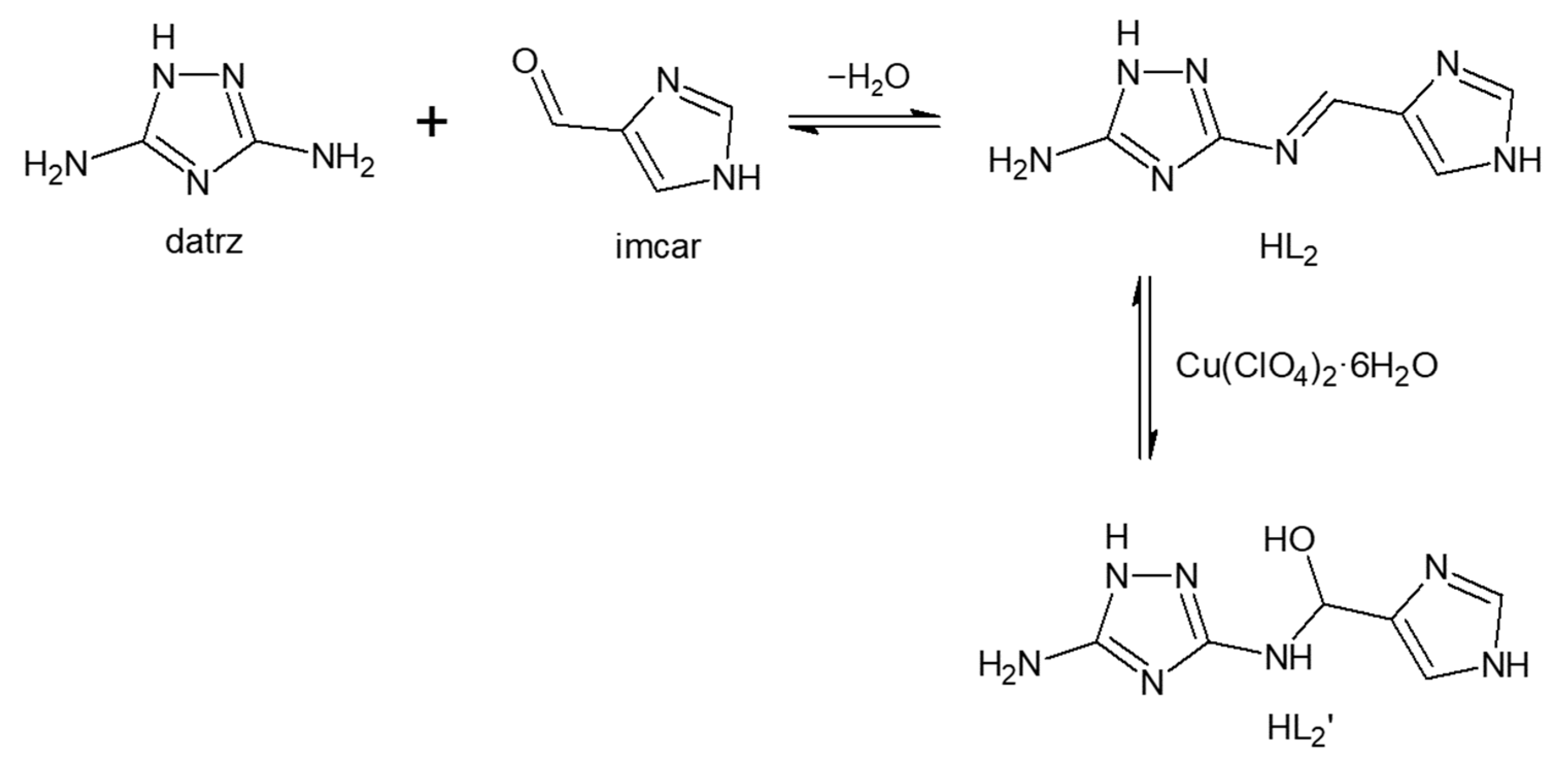
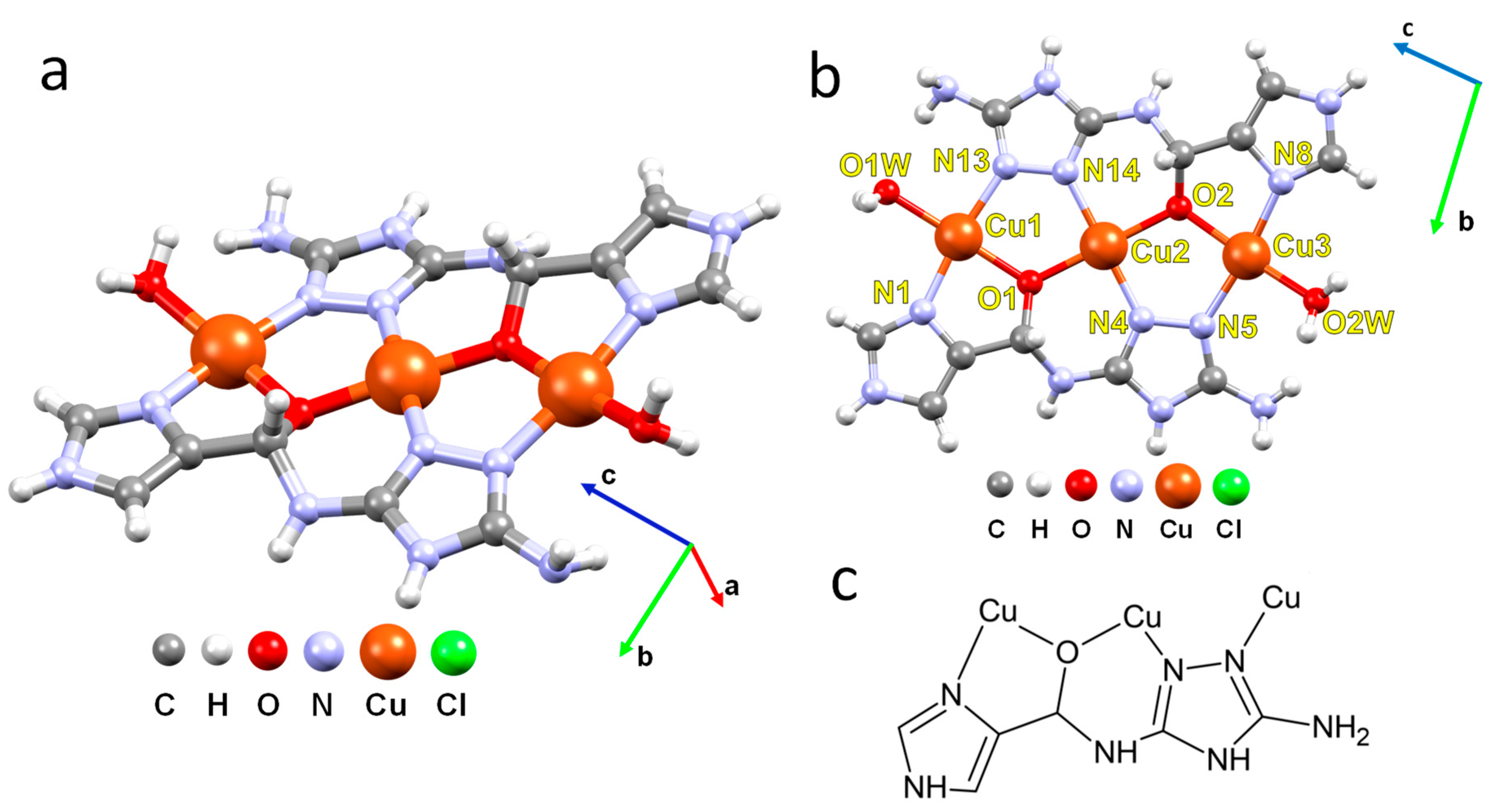
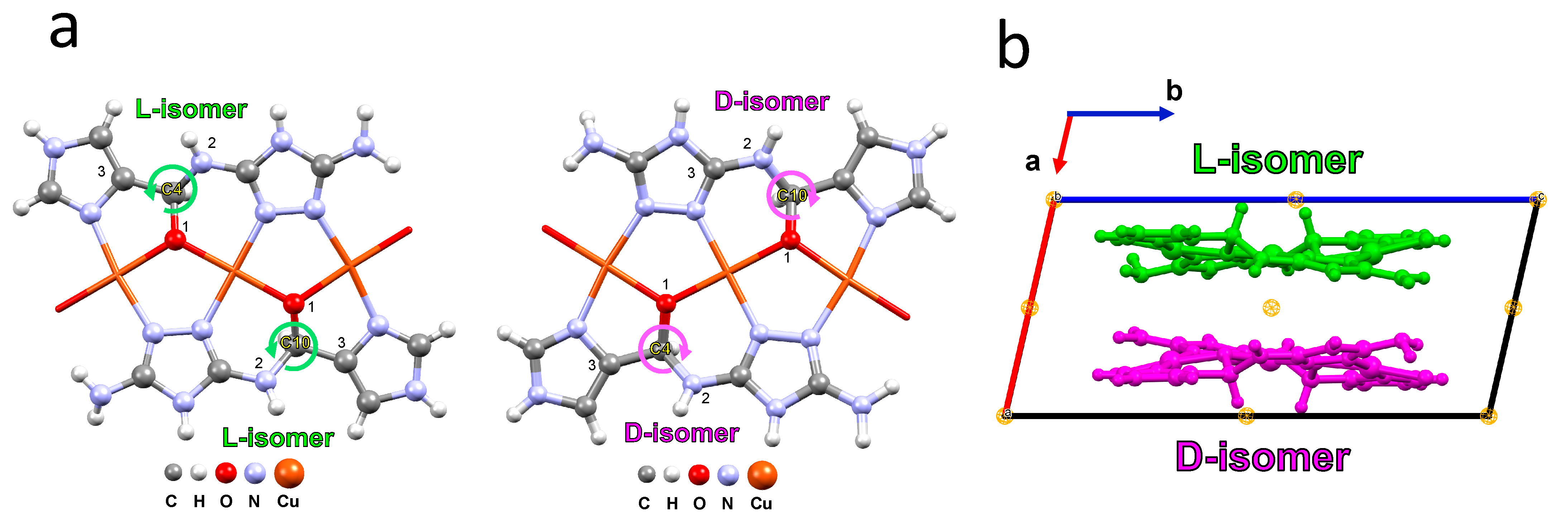
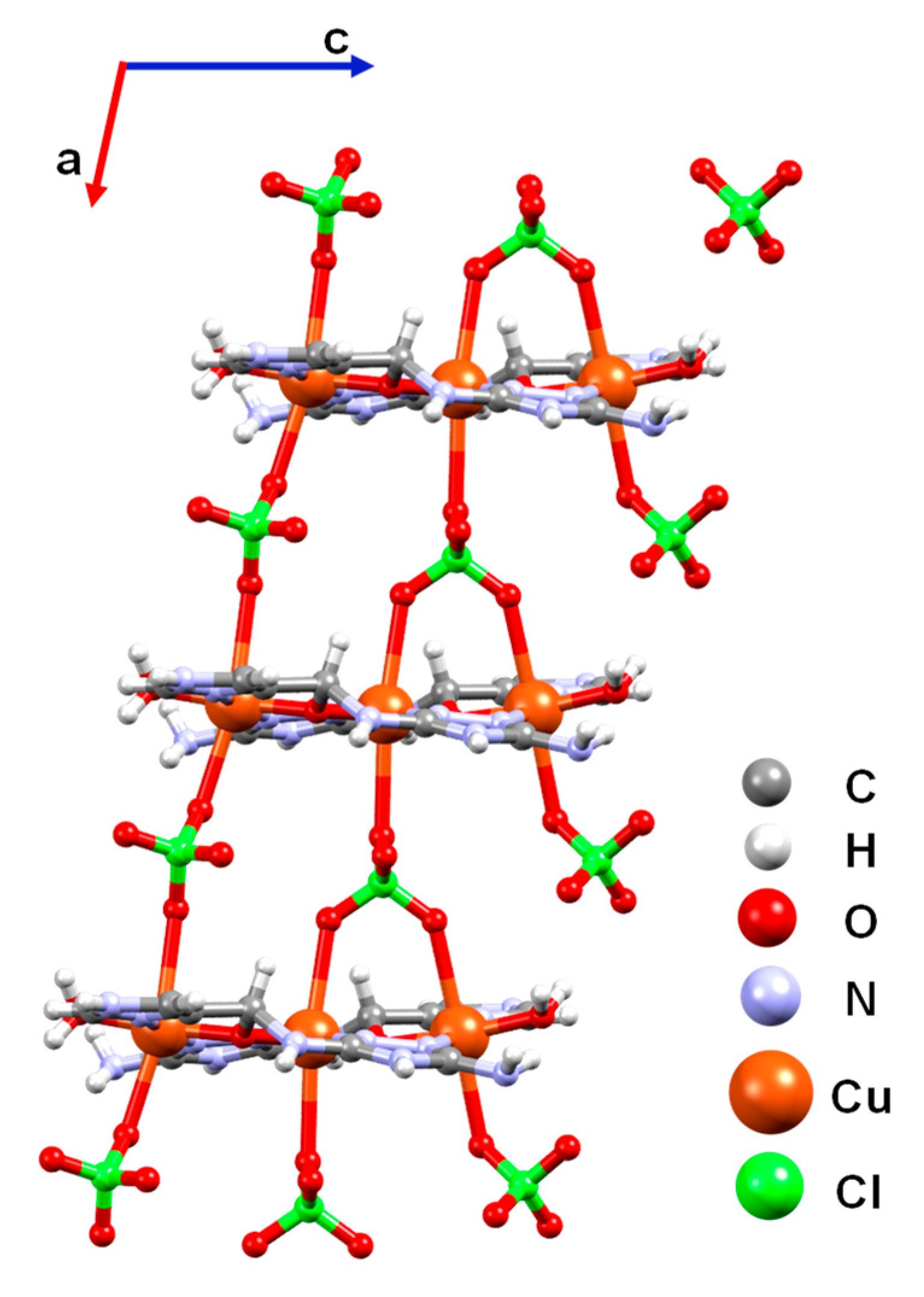
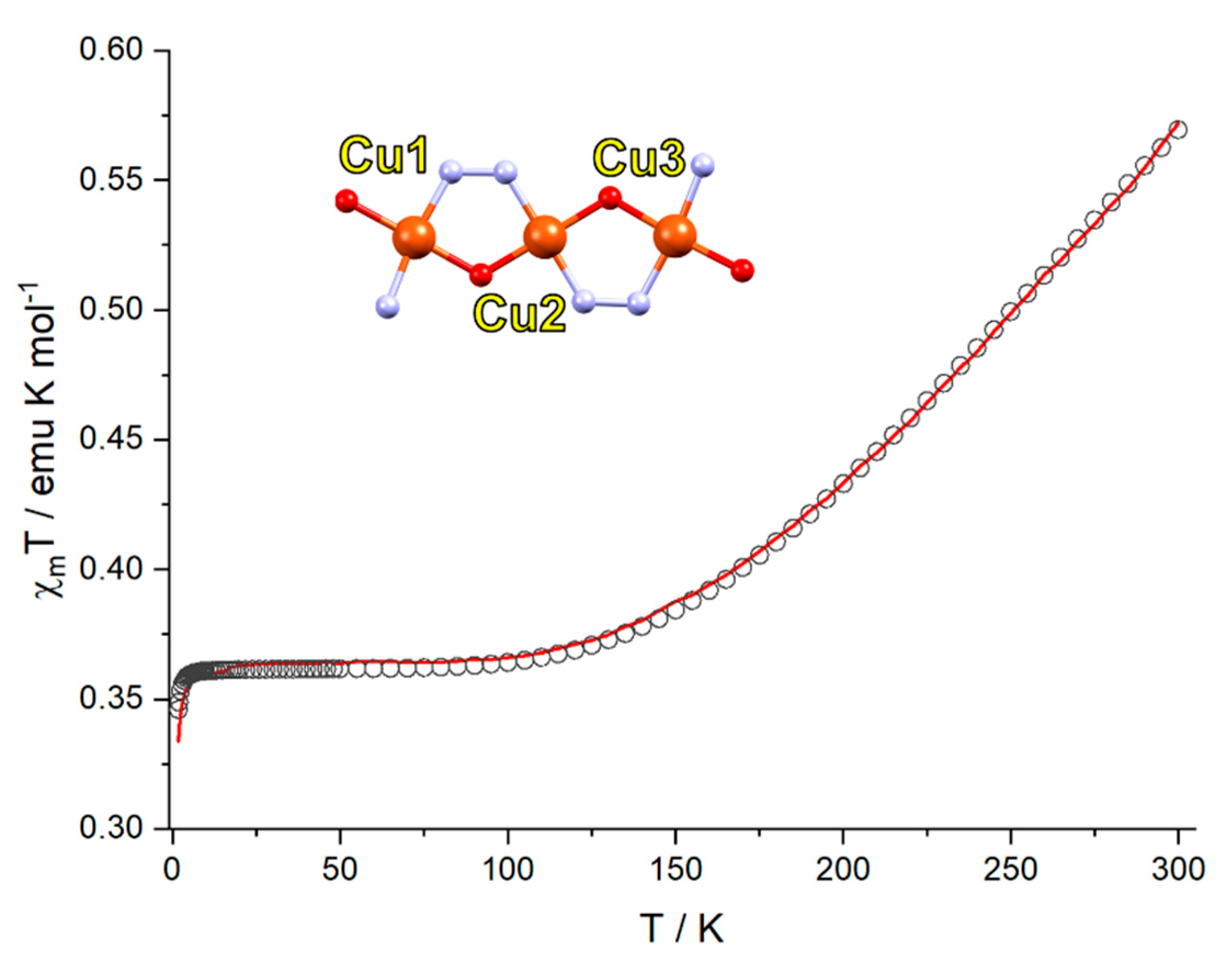

| Identification code | 1 |
| Empirical formula | C12H28Cl4Cu3N14O24 * |
| Formula weight | 1085.9 |
| Temperature/K | 296 |
| Crystal system | triclinic |
| Space group | P-1 |
| a/Å | 7.4052 (9) |
| b/Å | 14.7151 (17) |
| c/Å | 17.1455 (19) |
| α/° | 110.303 (4) |
| β/° | 100.416 (4) |
| γ/° | 94.458 (4) |
| Volume/Å3 | 1703.3 (3) |
| Z | 2 |
| ρcalcg/cm3 | 2.092 |
| μ/mm−1 | 2.284 |
| F (000) | 1066.0 |
| Crystal size/mm3 | 0.320 × 0.140 × 0.050 |
| Radiation | MoKα (λ = 0.71073) |
| 2Θ range for data collection/° | 2.598 to 55.254 |
| Index ranges | −7 ≤ h ≤ 9, −19 ≤ k ≤ 18, −22 ≤ l ≤ 20 |
| Reflections collected | 16,730 |
| Independent reflections | 7677 [Rint = 0.0629, Rsigma = 0.1129] |
| Data/restraints/parameters | 7677/0/513 |
| Goodness-of-fit on F2 | 1.109 |
| Final R indexes [I ≥ 2σ (I)] | R1 = 0.0854, wR2 = 0.2089 |
| Final R indexes [all data] | R1 = 0.1409, wR2 = 0.2379 |
| Largest diff. peak/hole/e Å−3 | 1.61/−0.90 |
| Cu-O Bond Length (Å) | Cu-N Bond Length (Å) | Cu-Cu Distances (Å) | ||||||
|---|---|---|---|---|---|---|---|---|
| Cu1 | O1 | 1.960 (6) | Cu1 | N1 | 1.939 (7) | Cu1 | Cu2 | 3.3635 (14) |
| Cu2 | O1 | 1.915 (5) | Cu1 | N13 | 1.979 (7) | Cu2 | Cu3 | 3.3284 (14) |
| Cu2 | O2 | 1.955 (5) | Cu2 | N4 | 1.921 (7) | Cu1 | Cu11 | 7.4052 (9) |
| Cu3 | O2 | 1.957 (5) | Cu2 | N14 | 1.939 (7) | Cu2 | Cu21 | 7.4052 (9) |
| Cu1 | O1W | 1.991 (6) | Cu3 | N5 | 1.966 (7) | Cu2 | Cu31 | 7.3084 (17) |
| Cu3 | O2W | 2.002 (6) | Cu3 | N8 | 1.946 (7) | |||
| Cu1 | O12 | 2.514 (9) | ||||||
| Cu1 1 | O14 | 2.660 (8) | ||||||
| Cu2 | O3 | 2.669 (7) | ||||||
| Cu2 | O51 | 2.747(8) | ||||||
| Cu3 | O6 | 2.617(9) | ||||||
| Cu3 | O9 | 2.510(9) | ||||||
| Compound | Cu-NN-Cu a | Cu-O-Cu b | J (cm−1) | Ref. |
|---|---|---|---|---|
| [Cu3(HYDRAV)2Cl2] c | 35.9 | 115 | −7.21 | [59] |
| [Cu3L2(BF4)(H2O)2](BF4)d | 40.5 (2)/33.0 (1) | 116.23 (7)/118.40 (7) | −170 | [60] |
| [Cu3L2(NO3)2(H2O)2](H2O)3 d | 28.86 | 116.95 | −113.1 | [60] |
| [Cu3L2(Cl)2(CH3OH)2](H2O)2 d | 30.54 | 116.89 | −98.3 | [60] |
| [Cu3L2(ClO4)2(H2O)2] d | 40.19/28.92 | 117.67/117.91 | −249.7 | [60] |
| {[Cu3L1(L2)2(NO3)2(H2O)2](NO3)·1.5H2O}n e | −6.9 (8)/8.0 (8) | 119.3 (3)/124.5 (3) | −149/−175 | [20] |
| Cu3(L3)2(OH)2(H2O)2 f | 13.1 | 124.2 | - | [61] |
| {[Cu3(HL′)2(H2O)2](ClO4)4}·(H2O)4 | 17.2 (8)/13.7 (8) | 120.5 (3)/116.6 (3) | −179 | * |
| Cu1–Cu2 (J1) | Cu2–Cu3 (J2) | Cu1–Cu3 (J3) | |
|---|---|---|---|
| Ja | −349.3 | −207.7 | −8.8 |
| Jb | −174.6 | −103.8 | −4.4 |
| Jc | −337.8 | −202.9 | −8.8 |
| ΔρHS (Cu) | 0.680 0.701 | 0.679 0.698 | 0.689 0.690 |
| ΔρBS (Cu) | −0.665 0.686 | −0.669 0.689 | −0.689 |
| ΔρHS (O) | 0.172 | 0.175 | |
| ΔρBS (O) | 0.021 | 0.019 | |
| ΔρHS (N) | 0.045 0.052 | 0.043 0.059 | |
| ΔρBS (N) | −0.052 0.057 | −0.056 0.052 |
Disclaimer/Publisher’s Note: The statements, opinions and data contained in all publications are solely those of the individual author(s) and contributor(s) and not of MDPI and/or the editor(s). MDPI and/or the editor(s) disclaim responsibility for any injury to people or property resulting from any ideas, methods, instructions or products referred to in the content. |
© 2023 by the authors. Licensee MDPI, Basel, Switzerland. This article is an open access article distributed under the terms and conditions of the Creative Commons Attribution (CC BY) license (https://creativecommons.org/licenses/by/4.0/).
Share and Cite
Cruz, C.; Audebrand, N.; Páez-Hernández, D.; Paredes-García, V. Novel Linear Trinuclear CuII Compound with Trapped Chiral Hemiaminal Ligand: Magnetostructural Study. Magnetochemistry 2023, 9, 175. https://doi.org/10.3390/magnetochemistry9070175
Cruz C, Audebrand N, Páez-Hernández D, Paredes-García V. Novel Linear Trinuclear CuII Compound with Trapped Chiral Hemiaminal Ligand: Magnetostructural Study. Magnetochemistry. 2023; 9(7):175. https://doi.org/10.3390/magnetochemistry9070175
Chicago/Turabian StyleCruz, Carlos, Nathalie Audebrand, Dayán Páez-Hernández, and Verónica Paredes-García. 2023. "Novel Linear Trinuclear CuII Compound with Trapped Chiral Hemiaminal Ligand: Magnetostructural Study" Magnetochemistry 9, no. 7: 175. https://doi.org/10.3390/magnetochemistry9070175
APA StyleCruz, C., Audebrand, N., Páez-Hernández, D., & Paredes-García, V. (2023). Novel Linear Trinuclear CuII Compound with Trapped Chiral Hemiaminal Ligand: Magnetostructural Study. Magnetochemistry, 9(7), 175. https://doi.org/10.3390/magnetochemistry9070175






